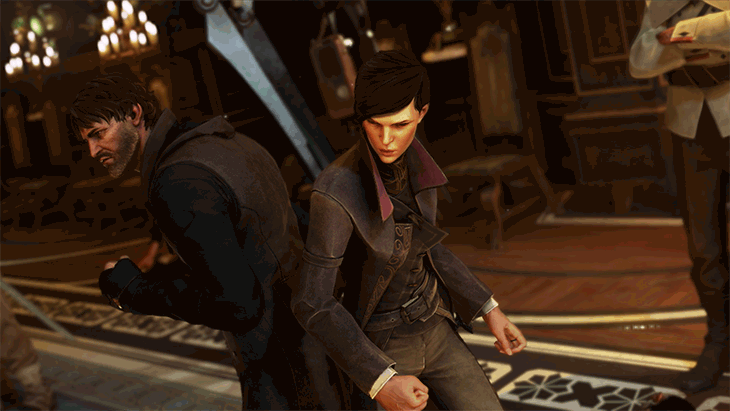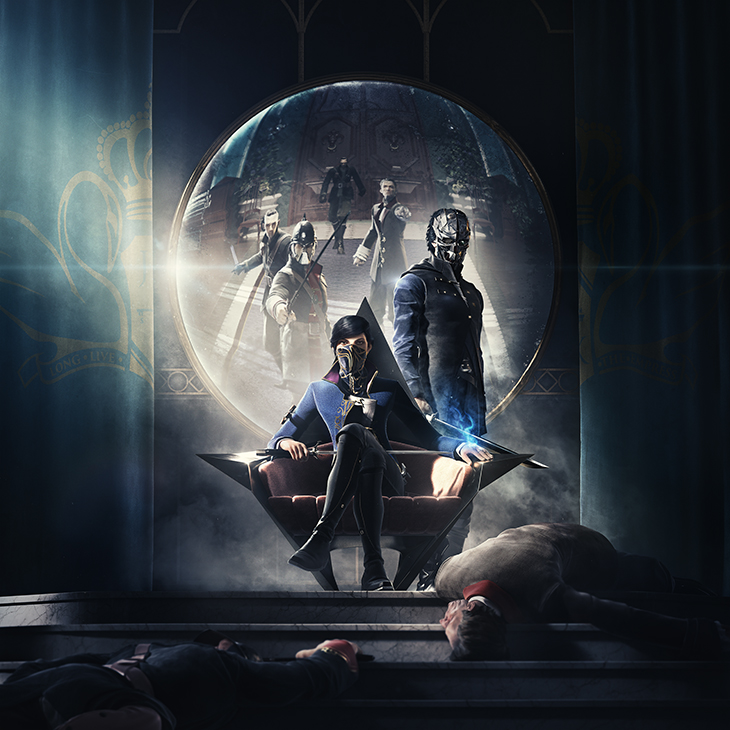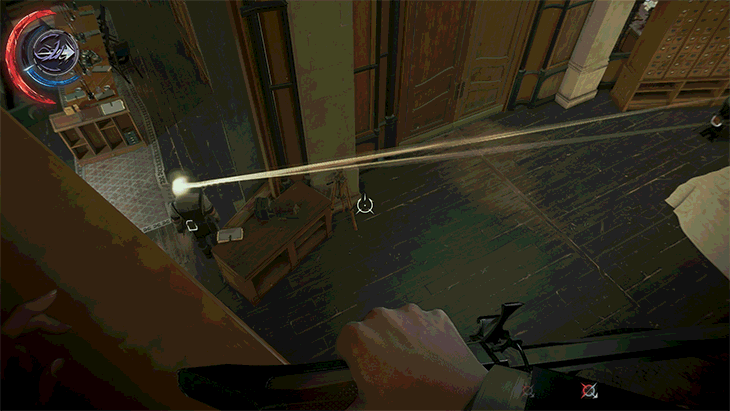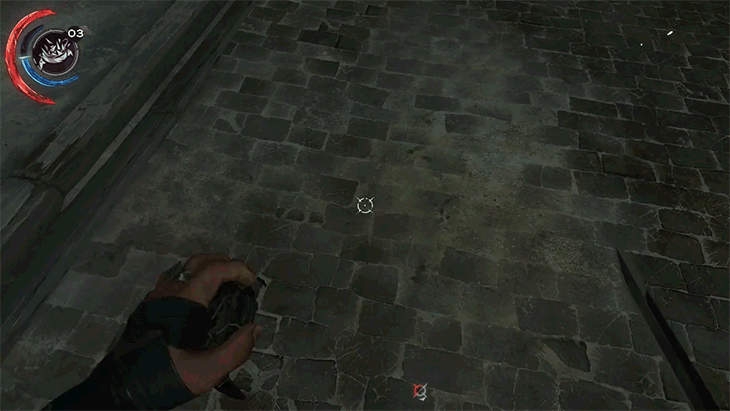GameSpot: I wanted to start by talking about your new protagonist, Emily Kaldwin--empress of the Isles and daughter of returning protagonist Corvo Attano. In a way, you could have simply added new abilities for Corvo, but instead you chose to introduce an entirely new character...
Smith: Those two decisions were separate, though. We knew we wanted to make Emily no matter what, and then we were like, "God, we really feel nostalgic about Corvo. Let's do both of them." At first, we were thinking, "Let's just throw all the powers into one big pool." Then it became more and more interesting to us to say, "No, the powers reflect their lives or their time in the world." Corvo has Rat Swarm because he got his powers during the Rat Plague. You can look at Emily: she's a ruler, so of course she has Mesmerize.
So do the two characters share any supernatural powers, or are their ability sets entirely separate?
Corvo has exactly the same powers as last time but with all these upgrades--three to five upgrades for each power. Emily has all-new powers. Then we have enhancements, which are the passive powers--your jump distance or your agility. There are some interesting ones, like Shadow Kill, where people turn to ash when they die. Corvo and Emily share those.
Can you talk a bit more about how Corvo's new upgrades work? What kinds of upgrades can players expect?
In Dishonored, you took the power, and there was one upgrade for it. Usually, that upgrade was: It works for a little bit longer, or it works a little faster. This time, we really wanted to do something more interesting than that, so we took the power, we gave you a good basic package of the power, and then we said, "How many different ways can we upgrade it?" We tried not to have symmetrical trees. We don't care about, "Each [power] has three [upgrades]," or whatever. We say, "Whatever tree is under that power, based on what we can come up with, fine."
Corvo's Devouring Swarm in the first game, the upgrade was: The rats are more vicious, they destroy bodies faster, and they kill people faster. That was it--one power, one upgrade. Now you can do that, but you also have an upgrade that allows you to make two swarms. You can be attacking two different groups of people with rats. You can also upgrade it to have large swarms. You can upgrade it so that your swarms follow you, so when you take off running or Blinking across the ground, there's a trail of rats behind you, Pied Piper-style. That's a light dive into how we break up the upgrades.
Obviously, the game supports both lethal and non-lethal approaches. How did that impact these ability trees?
Not at all. Usually, their powers can be used lethally or non-lethally. One of the four or five critiques that people gave of the first game, even the people who loved it, was that they wanted more non-lethals. It was confusing, because people would say things like, "You gave us all the lethal powers, like Bend Time." We were like, "You can stop time and walk through the room, and nobody is ever aware that you were there." That power can be used lethally or non-lethally.
Most of the powers are still like that. You can Domino four guys together and sleep dart one of them, and you've only spent one sleep dart to take down four guys. Or you can set one on fire, and they all burn to death. It's up to you. We have added a lot more non-lethal [options], like a non-lethal drop attack--when you fall on people, you knock them out instead of stabbing them, if you want.
Can you expand on Emily's new powers at all? Did having to account for her new abilities change the way you designed certain areas or scenarios?
Just to give you a couple of examples: Let's say there are three super difficult guys to fight in one room, and then there's a servant cleaning a tray in the other room. I link these three super-difficult-to-fight guys with the servant [using Domino], and I just walk over to the servant, hit and choke him out. He can't even fight. He goes down instantly, and they go down. That's a good example of an emergent effect for Domino that we didn't anticipate, but people have started doing that.
I wanted to ask specifically about the time-travel mechanic we saw during the E3 demo...
That's a good point for clarification, because it's not one of the supernatural powers--it's a function of one of the missions. We took all the missions [and] said, "What if they had some epic theme, either fictionally or game mechanically?" Each one does something a little different. You've seen the Dust District, with randomized dust storms that affect visibility and stealth. You've seen the Clockwork Mansion, where the walls, floor, and ceiling of the house can be reconfigured with levers. Similarly, there's a mission called A Crack in the Slab, where time itself is broken.
When you get there, the Outsider says, "Your supernatural powers won't work here." Blink, Bend Time, Domino, Far Reach--none of that works. He offers you this timepiece, and it allows you to look from one time period to the other, three years apart. One is in the present, when the house is ruined--flooded, pipes broken, rats, furniture all stolen or broken--and one's three years in the past, when the house was very nice. Music playing, guards walking, and food out on the table.
You can look through the lenses of this timepiece, flip them up and look through them, and see the other time. Time is flowing in both equally. You can move back and forth, at will--like you're walking through the ruined house in the present and you need to get through this barred door, and you look at the past and the door is open, but there's a guard patrolling the area. You watch him through the lens, wait for his back to turn, transition, and move behind him. That's an example of dynamically using it to solve problems.
When you're designing scenarios or environments, are you designing with player creativity in mind? Are you trying to encourage players to be creative, or is their creativity simply a byproduct of having all these abilities?
It's a bit of both. We rely on the fact that it's systemic, and therefore, things can be put together in different ways. The systems themselves enable people to play creatively, but then sometimes we also tweak the encounter itself.
There's a scene where two guards are beating a guy up for not paying money, and they're pushing him closer and closer to a Wall of Light, which is a security device that turns you to ash if you touch it. You can just watch the scene, or you can go intervene and save the guy. You're given that instant to make the decision. If you have Possession, you can do one thing; if you have Bend Time, you can do another. You could just stop time and go turn off the Wall of Light. There are many different things you could do. That kind of improvisational moment is what we live for.
What is it about that type of moment that appeals to you?
I don't know. It's like
Far Cry 2--my favorite of the Far Cry series--where you're constantly trying to sneak, but something's going wrong. And then in that split second, you have to dynamically react, fight-or-flight. It's really exciting. There's something thrilling about your plan going awry. In a tactical space, it all happens very fast, but we give you lots of tools to react and to change things.
Some players don't like that. What they like to do is: sneak into the room, hide under the table, watch everybody, plant a couple of electrical shock traps that stun people... They're very neat and tidy. The plan never goes awry for them. Those players are really gratified, too, by the ability to formulate a plan. If it goes wrong, then they're like, "What went wrong? This behaves according to rules. Let me back up and try to do it again." That's very gratifying, too, that we have players like that.
Right. In the original Dishonored, players could choose to go "high chaos" and murder everyone, or play "low chaos" and stay relatively stealthy. How will that carry into Dishonored 2? Will there be multiple endings again?
The endgames are much more nuanced than last time. They're not just a gate at the end, but they're rather branches along the way: who you supported and who you didn't support, and who you killed and who you didn't. It makes a series of permutations of the endgame. Put all those permutations together, and then put different voice-over with commentary on it, and you have very many different states.
Will we see the impact of high and low chaos styles manifest in more nuanced ways throughout the campaign at all?
We have more bodies--bloodflies lay their eggs in corpses, so the more corpses you leave, the more bloodflies there are. Entire apartment buildings you could have passed through and looted before are now filled with bloodflies. It becomes a very dangerous path. Dialogue changes; people around you get more cynical. Security goes up in high chaos as well.
Also, now, we have the player-character voices. They change, and that's a powerful tool. You can not only emote through the character, but you can also give clues. Emily goes, "Oh, that's the Clockwork Mansion," and even if you didn't realize that you'd reached the Clockwork Mansion, you're like, "Aha, that's the Clockwork Mansion!" You can also reflect chaos with it, so Emily gets more cynical as well.
So I'm guessing she grows more and more outwardly cynical with each person she kills?
We found that last time, people were deciding who to kill or not based on the Heart. They'd pull out the Heart, they'd point it at a guy, it would whisper some secrets about him, and if [players] thought he sounded like a dick, they killed him. In their minds, bad people contributed less to chaos. That wasn't actually mechanically true, but because they believed it was true, we said, "We need to make that true this time." We added a system where people in the world are either sympathetic, guilty, or murderous.
Killing people contributes to chaos; it destabilizes the world around you. But killing a sympathetic person is worse in terms of weighting than killing a murderous person. That's a concession we made to the more nuanced desire that players had. Also, it solved a problem, because players were like, "Oh, it just comes down to killing fewer than 20 percent of the people." Not anymore. The weighting is different character to character.
At the beginning of a given mission, we take all the characters in the world--the random guards and such--and we procedurally decide whether they're sympathetic, guilty, or murderous, so every time it's different.
Does this apply to assassination targets as well? Can players still choose to eliminate targets in story-driven ways?
It's a big part of the franchise, in my opinion. We came up with that idea halfway through Dishonored 1. It was a lot of work, but then we came up with these clever things [like] the Heretic's Brand for the religious leader--once you're marked with it, no one from the religion will even talk to you. We decided we have to do that for the new game. You can avoid all the guards, you can use sleep darts, you can choke them out, but for the assassination targets, everybody has a poetic justice non-lethal elimination.





















![The Year of Incline [2014] Codex 2014](/forums/smiles/campaign_tags/campaign_incline2014.png)
























